
Dialogue substitution, a Quick ESL reading and speaking acti...
79K views · Nov 23, 2022 eslactivity.org
If you want to help your students out with remembering new vocabulary words, then check out this ESL dialogue activity. Instead of just reading an ESL dialogue mindlessly, students have to fill in the blanks with keywords that you’ve given them. Teaching English with dialogues is one of my favourite ways for students to see new words or grammar points in context. This TEFL activity is a nice way to increase the difficulty of a simple ESL conversation dialogue that you can often find in textbooks. Try this out for dialogues for ESL students and you'll notice a difference in how engaged students are when reading it. ------------------- Find out more about dialogue substitution: https://eslspeaking.org/dialogue-substitution/ -------------------- Want to find more activities for teaching ESL, including dialogue substitution? Check out: https://amzn.to/3dYOAJX -------------------- Here's another classic ESL activity: https://www.youtube.com/watch?v=moqF6Ef2Q4k -------------------- https://www.facebook.com/eslspeaking https://www.pinterest.ca/eslspeaking/ https://www.instagram.com/jackie.bolen/ https://www.tiktok.com/@englishwithjackie?lang=en #teachingenglishwithjackie #esl #tefl Transcript for dialogue substitution: Today, I'm going to talk about dialogue substitution. It's one of my favourite ESL reading and speaking activities. Have you ever experienced this in your class? It happens to me all the time. You know, there are those little dialogues in the textbooks that are often kind of like the lead-in to the rest of the unit. I put students into pairs and I tell them, okay read the dialogue with your partner and it is blah blah blah blah blah blah blah blah blah and they're finished. And then I say okay so that guy Bob and ask a question about Bob from the dialogue. Everyone's like, what who's Bob and they actually like legitimately have no idea who Bob is, what bob did, what bob said, even though they had just finished reading it with their partner. Do you know what the problem is? It's not with my students, it's with me because I didn't give them a reason to actually read carefully. This is the ultimate way to combat that so this does require a bit of prep. Photocopy the page in your textbook, take out some of the keywords and then students have to read it together with their partners but they have to fill in the blanks with these keywords. The keywords could be things like the verbs, like the past tense verbs, or they could be things related to food or drink if you're teaching food or drink. Sometimes, I'll put a little word bank at the top. Sometimes I won't. It kind of just depends on the level of the students so it turns it from a simple reading out a loud exercise to an exercise that focuses on meaning as well. Students actually have to pay attention to what they're reading. All right so that is my quick tip to make dialogues more interesting, engaging, difficult, and fruitful for your students. If you like this quick teaching tip, please be sure to hit like, subscribe, leave a comment below and let me know if you tried it out and what you think about it. Tags: Classroom games, ESL adults, ESL kids, TEFL, TEFL activities, TEFL classroom, learn English daily, TEFL game, 4 skills ESL, 4 Skills ESL game, 4 skills, Dialogue, dialogue substitution, study, studying, classroom, classroom activity, teaching English with dialogues,
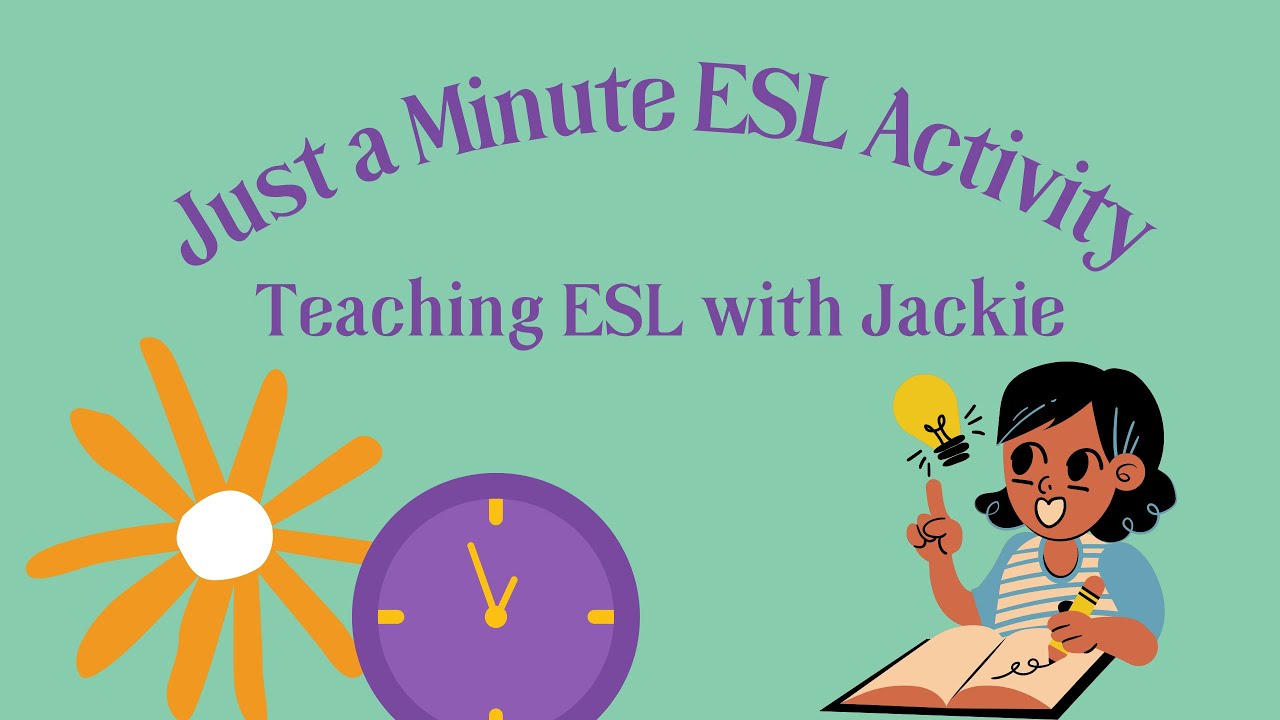
Just a Minute ESL Speaking Activity: Try out this Fun TEFL S...
59K views · Nov 23, 2022 eslactivity.org
Just a minute game is one of my favourite ESL speaking activities. It's perfect for a warm-up at the beginning of your class. It's also a nice speaking game for kids. The Just A Minute TEFL Speaking Game is a fun “Toastmasters” kind of ESL speaking activity. I like it because it gets students working on speaking fluently, without worrying too much about accuracy. Check out the video to find out all the details you need to know about this one-minute speech topic activity that’s perfect for English learners who are at an intermediate or advanced level. Quick tip for Just a Minute ESL: If you want to turn Just a Minute into more of a conversation or listening activity instead of just a speaking one, you can get each “listening” student in the group to ask 1-2 follow-up questions to help ensure active listening. I actually prefer this because it gives the other students in the group a reason to listen, instead of just sitting passively doing nothing. ------- More ESL activities • Error Correction TEFL Relay Race : https://youtu.be/78gr3NXAnQ4 • Ideas for Speaking Activity in English - (ESL Activities) by: @Yearn 2 Learn Y2L : https://youtu.be/EbjHeR6uOEA ------ Full blog post for Just a Minute: https://eslspeaking.org/just-a-minute-game-esl-speaking/ https://www.facebook.com/eslspeaking https://www.pinterest.ca/eslspeaking/ https://www.instagram.com/jackie.bolen/ https://www.tiktok.com/@englishwithja... #esl #eslactivities #teachingenglishwithjackie ------------------------------------------------------- Even more Ideas for the TEFL Classroom: https://eslspeaking.org/ -------------------------------------------------------- Timestamp: 0:00 Intro 0:20 How to play Just a Minute ESL activity 2:26 Why this is a great speaking activity 2:54 Check out 101 ESL activities book Transcript: Hi, this is Jackie from eslspeaking.org. Today I'm going to talk about one of my favourite ESL speaking activities called just a minute. This is the ultimate activity for intermediate or advanced students to work on speaking and speaking fluency. I put students into groups of four and then I write many different topics on the board. Just things that students could talk for one minute about without stopping, so for example, like a favourite restaurant, high school memory, favourite sport, a tv show that they like, a game that they play, their family, just those kinds of common topics that anybody could actually talk about. So, in groups of four, I get students to give themselves a number one, two, three, or four. Then I say okay number ones, you're going first. Then I scrunch up a ball of paper and I give it to one of the students kind of in the front rows and they throw the ball at the whiteboard with all the little topics on it and whatever the ball hits, that's the first topic. Each of those people is kind of put on the spot, the number ones in each group. They have to talk for 60 seconds without stopping about that topic. I put a timer up on the PowerPoint screen and it counts down. And I just say this is your challenge: you must talk for one minute without stopping. It can be a little bit challenging for some students but most students are kind of able to do it as long as the topic is familiar enough so don't choose any obscure things or this will be much too difficult. So the other three members in the group: number two, three, and four have to listen to that person talking and then they have to think of one or two interesting follow-up questions for that person once the minute is done and they stop talking. So this is kind of optional but it's the best way to encourage active listening so if you don't do this the other members of the group will be thinking about those topics on the board what they're going to say, planning out their own speeches, etc. and it becomes not a speaking and listening activity it just becomes a solely speaking activity. So once that first person is done with a one-minute speech and then the follow-up questions, number two goes so they throw the scrunched up paper at the board and then the second topic. That person talks for one minute, follow-up questions and then number three and number four go. I also love this activity because it requires no preparation and no materials. It's quite useful for the students generally, they like it and yeah it's a great way to fill up like 20 or 30 or even 40 minutes in your class. In some cases, if you have some discussion about the topics or kind of elicit some answers about what people said about each thing and the teacher can ask some follow-up questions to the people as well. Be sure to check out my book 101 ESL Activities for Adults. Tags: Just a minute game, Speaking activity topics, Just a minute, topics for speaking activity, adults, just a minute, just a minute activity,esl just a minute, just a minute esl, teaching english speaking, teaching esl speaking,esl speaking adults,esl speaking teenagers, warmer,esl warmers
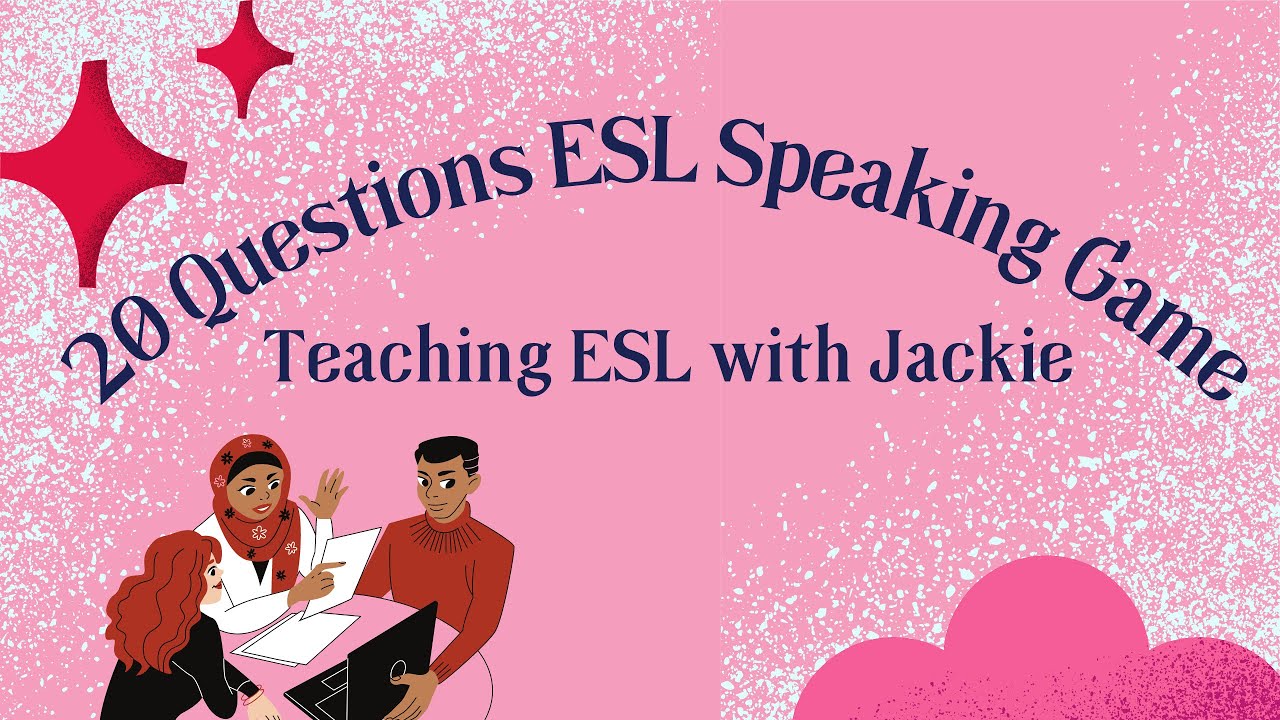
ESL Speaking Game: 20 Questions | 20 Questions For TEFL Stud...
36K views · Nov 23, 2022 eslactivity.org
I’m sure you’ve played the game “20 questions” before. It’s basically where someone thinks of a secret noun (person, place or thing) and the other team or person gets to ask up to 20 questions to figure out what it is. 20 questions works well for ESL/EFL learners as well. It’s a fun way to get ESL/EFL students practicing questions and working on some basic vocabulary. Keep watching to learn more about using twenty questions in your English classes. It's a nice time-filler or end-of-the-class activity when you have a few minutes to spare. ------------------- • A Simple ESL Listening and Speaking Activity: Me Too: : https://youtu.be/gMGR2tV2Xe0 • Top Speaking Games/ Activities! ESL by: @Tasnim Salah https://youtu.be/YYfDFfmAufY ------------------- More details about 20 questions for ESL: https://eslspeaking.org/20-questions-esl-speaking-game/ Want to find more low or No Prep ESL activities? Check out: https://amzn.to/3KbTtgU -------------------- Check out another ESL speaking activity: https://www.youtube.com/watch?v=8MMCLcm58-A --------------------- https://www.facebook.com/eslspeaking https://www.pinterest.ca/eslspeaking/ https://www.instagram.com/jackie.bolen/ https://www.tiktok.com/@englishwithjackie?lang=en #teachingenglishwithjackie #20questions #eslgames Transcript for ESL 20 Questions: 0:00 Intro 0:35 Teaching tips for 20 questions 1:36 Variation for beginners 2:10 Prevent random guessing 3:03 Conclusion Today I'm going to talk about one of my favourite ESL activities called 20 questions. So I'm sure you've played 20 questions before with your friends or family members. It's where someone thinks of a person, place, or thing and then you have 20 questions to ask them in order to figure out what that person, place, or thing is. You can play it with your more advanced students just kind of as-is, where the person can literally think of anything and then the other students will ask questions to that person to figure it out. However, there is kind of a couple of things that I do in my ESL classes in order to just make it go more smoothly. I will usually choose the first thing and then get students to ask me questions but then whoever guesses the thing correctly, or the person, or the place, or thing correctly, can go next and have the secret thing. However, I get them to tell me what it is because you know maybe they don't quite understand the question. Maybe it's some like super, super obscure thing like an armadillo that probably the rest of the students in the class don't even know. So I've had definitely like some angry students before when I haven't done that so this is just the easiest way to combat that so you can kind of like cut things off at the pass for someone choosing some too obscure thing that nobody else knows. Or, if they answer a question incorrectly, I can say oh hold on, actually, the answer to that is yes or the answer is no. Then, another variation of this is to do something like 10 questions so I would use this for more beginners. I choose a category based on whatever I'm teaching, so jobs or animals and I'll choose a job and I'll tell the students it's a job and then they have 10 questions to ask and figure out what the job is, or animals, or whatever else you're doing. If you have 20 questions or 10 questions, a guess also counts as a question. If you don't say this, students will often say if I say it's an animal they'll say, cat, dog, fish, tiger, elephant. Of course, it's just like they're not even asking questions and they're barely speaking English. It's just kind of a total waste of time so if you make an answer count as a question as well to go up to their total, then it prevents the random guessing. They have to ask a yes or no question. Does it have four legs? Yes. Does it live in the water? Yes. Things like that and then they can just go and they'll actually ask better questions than just making random guesses. All right, that's it. It's kind of the ultimate time-filler warm-up activity. It's kind of just one of those things to have in the back of your mind if you get this like last-minute class or you have a few minutes left over at the end of class and nothing's going on. You don't want your students just to have a bunch of downtime to like do whatever they want to do. Just pull up this fun game and students really seem to enjoy it for sure. Tags: ESL Speaking Game,asking questions esl, 20 questions game ideas, 20 questions game, TEFL Students, activities for non english speaking students, learning games, teaching esl, teachers, teaching activities, fun activities, games, english, learning english, esl games, english teacher, english, learning language, Classroom games, ESL adults, ESL kids, TEFL, TEFL activities, TEFL classroom, 20 Questions, Question Games
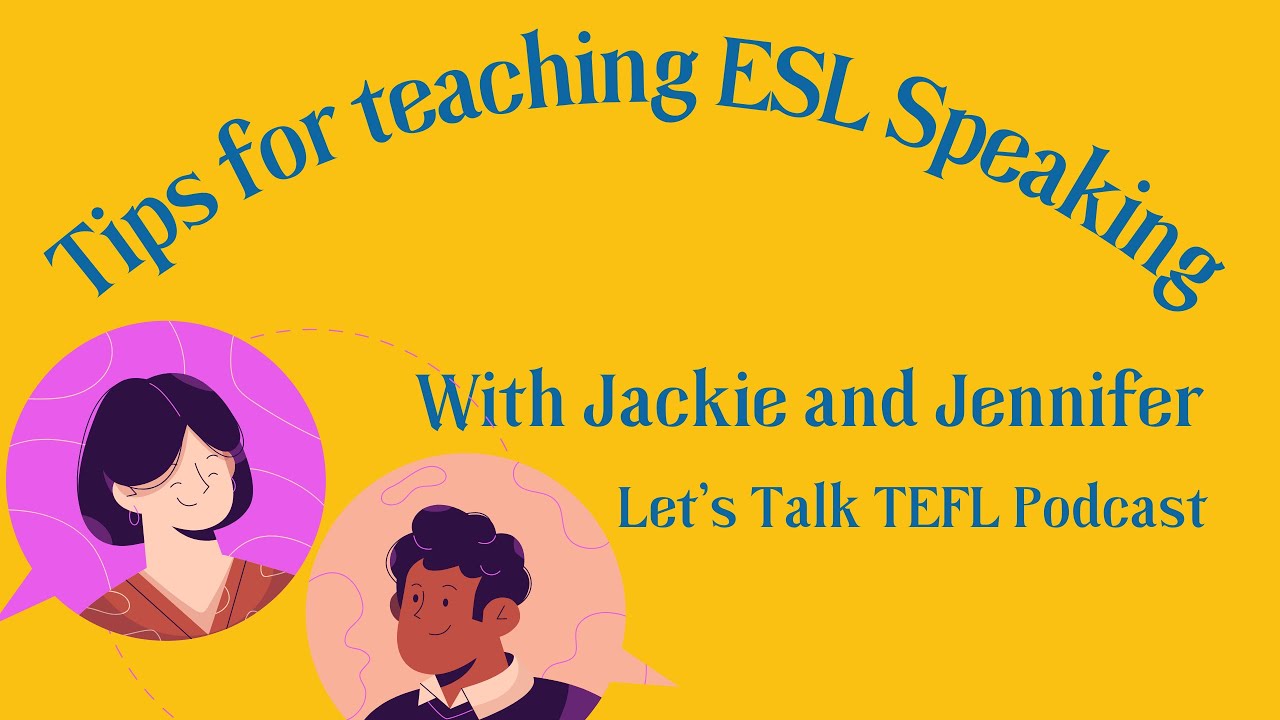
Teaching ESL Speaking: Lesson Plans, Tips & tricks for E...
15K views · Nov 23, 2022 eslactivity.org
Find out all the tips and tricks you need for teaching ESL speaking, including speaking activities, general tips and an ESL speaking lesson plan template. Teach English speaking in a student-centred style to all ages and levels with these ideas from Jackie and Jennifer. ------ • ESL Speaking Lesson Plan Template: https://eslspeaking.org/esl-speaking-lesson-plan-template/ • Writing Lessons: How to Teach Writing Skills to ESL Students : https://youtu.be/Dzue9mIZRzo ------- Subscribe to the podcast "Let's Talk TEFL" here: https://www.buzzsprout.com/1774520/9007639 Episode 14, How to ESL Classrooms More Student-Centred: https://www.buzzsprout.com/1774520/8815275 ESL Board Games: https://eslspeaking.org/esl-board-games/ ESL Surveys: https://www.eslactivity.org/esl-surveys/ 39 No-Prep/Low-Prep ESL Speaking Activities: https://amzn.to/3rpglB4 And the same book but for kids: https://amzn.to/3Ii5MXj Find Jennifer at: https://www.teachtravellearn.com/ Podcast info: https://www.eslactivity.org/podcast/ https://www.facebook.com/eslspeaking https://www.pinterest.ca/eslspeaking/ https://www.instagram.com/jackie.bolen/ https://www.tiktok.com/@englishwithjackie?lang=en https://www.facebook.com/eslspeaking https://www.pinterest.ca/eslspeaking/ https://www.instagram.com/jackie.bolen/ https://www.tiktok.com/@englishwithjackie #esl #teachingtips #teachingenglishwithjackie ------------------------------------------------------- More ESL Speaking resources: https://eslspeaking.org/ -------------------------------------------------------- Timestamp for Teaching ESL Writing: 0:00 Introduction 0:08 LET'S TALK TEFL WITH JACKIE AND JENNIFER 0:22 ESL SPEAKING ACTIVITIES 0:37 GENERAL TIPS 3:38 DO BOTH QUESTIONS AND ANSWERS 5:24 GUIDANCE IS REQUIRED FOR BEGINNERS 7:07 SURVEYS ACTIVITY 9:31 TALKING BAG ACTIVITY 12:05 BOARD GAMES ACTIVITY 16:42 VOCAB UNO ACTIVITY 18:56 HOW TO PLAN AN ESL SPEAKING LESSON PLAN 19:25 SET THE CONTEXT FOR A LESSON PLAN 20:51 INTRODUCE LANGUAGE THROUGH READING OR LISTENING 24:43 STUDENTS NEED TO TALK ABOUT UNFAMILIAR AND FAMILIAR TOPICS 25:16 CONTROLLED PRACTICE 26:44 FREER PRACTICE Tags: Teaching ESL Speaking,speak lesson plan,esl lesson plan samples,sample lesson plan for ell students,esl lesson plan templates,speaking lesson plan, esl, esl speaking, teaching ESL, teaching English, learning English, teaching college, teaching university, teaching tips, ESL tips, English Teacher, esl podcast, podcast, how to teach English, Teaching English Speakers, Lesson plans,
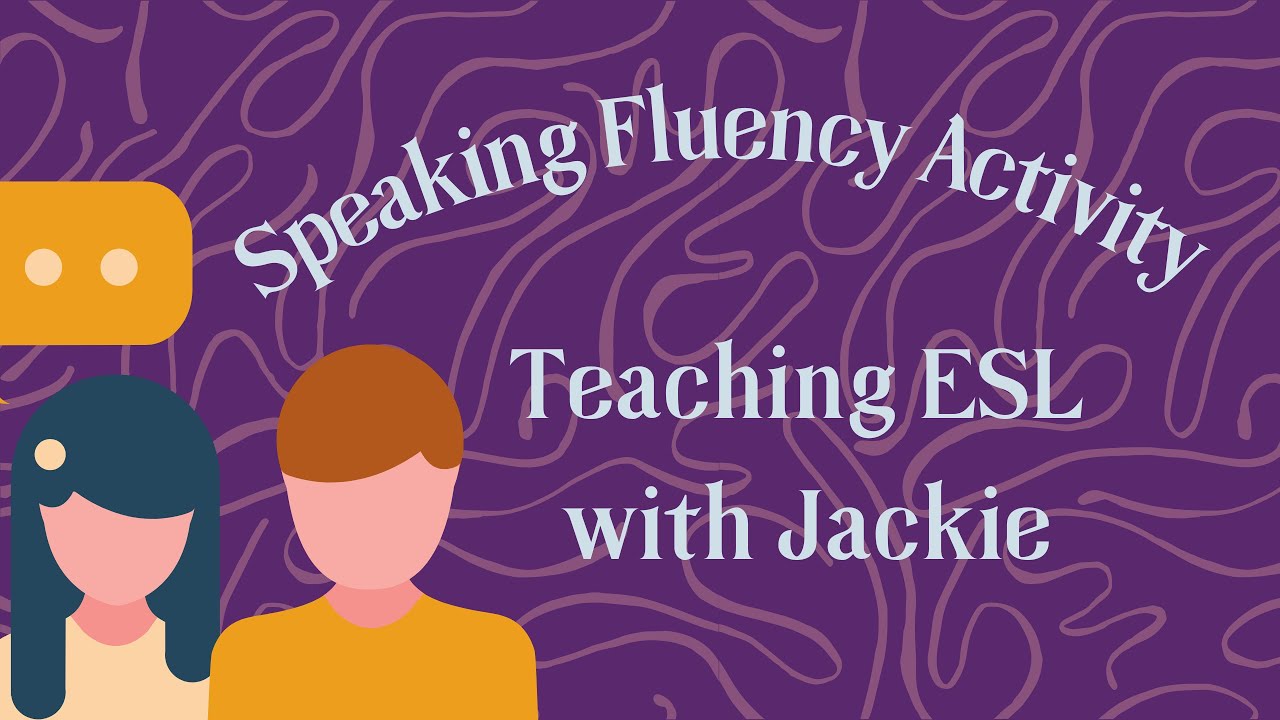
ESL Speaking Fluency Activity: 120-90-60 | How to speak Engl...
15K views · Nov 23, 2022 eslactivity.org
All of our students want to speak more fluently in English! It can be difficult to help your students with this though because most of the activities you’ll find in textbooks focus more on accuracy. However, teaching English speaking fluency can often be quite a difficult task. That's why you'll need some good TEFL speaking fluency activities like this one, 120-9-60. Help your students speak more quickly in English. ------------------- • Here's another one of my favourite speaking activities: https://www.youtube.com/watch?v=dnlcp_EI2n8&t=2s • Speak English Fluently by: @Oxford Online English https://youtu.be/KaA_mxga3PQ ------------------- Learn more about this speaking fluency activity: https://eslspeaking.org/120-90-60-fluency-speaking-activity/ Want to find more ESL Icebreakers? Check out my book: 39 ESL Icebreakers here: https://amzn.to/3cQ9M3K -------------------- https://www.facebook.com/eslspeaking https://www.pinterest.ca/eslspeaking/ https://www.instagram.com/jackie.bolen/ https://www.tiktok.com/@englishwithjackie?lang=en #teachingenglishwithjackie #speakingfluently #englishspeakingpractice Timestamp 0:00 Intro 0:56 How to do the activity 1:32 Follow-up questions 1:52 Switch roles 3:02 Class feedback 3:25 Conclusion Transcript for 120-90-60: Today I'm going to talk about one of my favourite activities to work on speaking fluency. When you're teaching speaking, there's kind of two different things. There's accuracy which is like correct grammar, and correct word choice or there's fluency which is how quickly and easily students are able to talk. I find most ESL textbooks and even most teachers and I mean I'm guilty of it too, focus on accuracy because it's much easier to say to someone, your grammar was incorrect or use this word instead of that word than it is to tell students to speak faster. I mean, you can't really say that students will often just speak at the pace that they speak so I like to use this activity in my classes in order to help students work on that and build some confidence that they actually are able to speak more quickly. I get students to prepare a short speech based on something that they know quite well so it kind of depends on the topic of the day or the grammar or vocabulary that I'm teaching but it could be something like your favourite restaurant or talk about like a memory from high school if you're talking about the simple past or something like that. And then I get students to make some notes, one or two words per line but they're not allowed to write full sentences. And then I put them in pairs and the students have to talk for 120 seconds or two minutes to their partner about that topic. At the end of that two minutes, the person listening has to ask one or two follow-up questions. The follow-up questions are actually not super important but I do that to encourage active listening so the other person just isn't thinking about what they're going to say and paying no attention actually to what this other person is talking about. So after they talk for two minutes and then one or two follow-up questions, they switch roles and the other person talks for two minutes and then one or two follow-up questions. Then after that, I get students to switch partners and then they have to give that speech again, saying all the same things but they have only 90 seconds this time so they have to speak more quickly but most students are able to do this because it's fresh in their head and saying something the second time, of course, is easier than saying something the first time. And so then the same thing happens they speak for 60 seconds one or two follow-up questions switching roles and then do it again or sorry 90 seconds they speak for 90 seconds and then they switch partners again and then the third round they have to speak in 60 seconds including all the same things. So this is where it gets a little bit difficult. Not all students will be able to do it because the information from two minutes, cut down to one minute is not that easy to include even if you speak very quickly but most students will give it a good try and do quite well and it is the third time that they are saying it. So the same thing happens: they do the speech and then follow up questions and then switch roles. And at the end of that, I'll get the whole class together and I'll get them to give me some feedback about how it went, what was difficult, if they felt confident that their time, things like that. So we have a bit of a discussion about how it felt to actually speak more quickly, probably than they've ever spoken English in their entire lives. Probably this is the most quickly they've done it. Tags: ESL Speaking Fluency,speaking fluency,fluency activities,fluency lesson plan,fluency lesson plan,120-90-60,How to speak fluent English
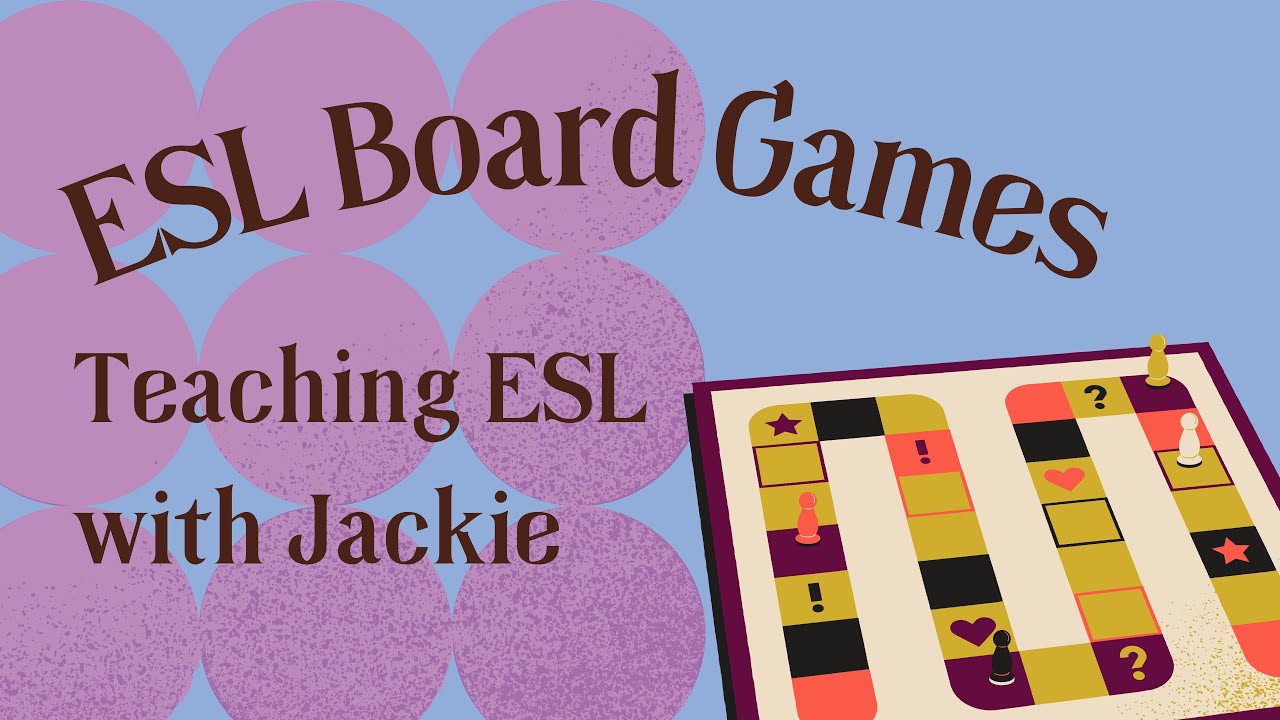
TEFL Speaking Board Game for Students: ESL Board Games | Tea...
93K views · Nov 23, 2022 eslactivity.org
I’ve used board games for English learners many times as a review activity in the class before a midterm or final exam. It’s quite easy to make a question to cover just about everything you’d possibly include on a test in a conversation class, or general English class. Students love them, and they’re an excellent way to recap a class or unit. Try out ESL board games before a midterm or final exam! ------------ • Check out these fun, engaging, and student-centred ESL games and activities : https://youtube.com/playlist?list=PLL0Q8kr18oQKbg2gr0CIt-ibFPl8f4oCL • Playing Board Games to Practice English by: @Mara Cares https://youtu.be/y5L8CYa-j_Y ----------- Even more advice and ideas for using board games in TEFL classes: Full blog post: https://eslspeaking.org/esl-board-games/ Want to find more low or No Prep ESL activities, including Board Games? Check out: https://amzn.to/30ZLSzS ------------ https://www.facebook.com/eslspeaking https://www.pinterest.ca/eslspeaking/ https://www.instagram.com/jackie.bolen/ https://www.tiktok.com/@englishwithjackie?lang=en #teachingenglishwithjackie #20questions #eslgames Timestamp 0:00 Intro 0:15 One super-tip 0:33 It's easy to make your own board games 1:39 All about dice 2:16 What about actual board games? 2:53 Conclusion Transcript for ESL board games: Hi, this is Jackie from esleaking.org. So today I'm going to talk about using board games in ESL classes. First of all, before we get any further one super tip that I have for you is to check the teacher's resource book that goes along with the textbook that the students are using. You can often find some great board games in there so just all you have to do is photocopy and bring them to class and then you'll have a great time with your students and it's really that simple. However, not to worry if you don't have a teacher's resource book,. You can make your own board games super easily. Some topics and grammar points lend themselves better to board games than others Some things that I like to use them for are should and shouldn't, for giving advice, the simple past, likes and dislikes, as well as frequency adverbs like always sometimes etc. The way I make my own board games is I have a template in google drive and then on that board, I have squares like one, two, three, four, five, six, seven, and it goes down to about 30 and the students just have to follow the numbers in a line. And then I have some special squares like trade places with the person on your left, go back five, free take a rest, things like that. But otherwise, the rest of the squares will have, for example, if I'm doing problem and advice they would have a question, they'd have like a problem like I can't sleep at night and then the student would land there with their token and then they would have to give some advice to that person. You shouldn't drink coffee before bed. And then the other spaces would be filled with different questions. The way that you can roll dice for board games, actually, I hate using actual dice because it's super loud and I find the dice roll all over the classroom. It kind of just gets too crazy so there are a few different methods for this. I like to use two coins, so for example, heads and heads equal four, heads plus tails equals two, and then tails plus tails equals one, something like that. Or, you can get a number grid and students close their eyes and then move a pen around and whatever their pen touches, that's the number for like three or five, etc. That's how you make your own board games. If you want to use some board or card games just for kind of a fun party day in your class, some of the easier ones I recommend are Scrabble, Uno, Monopoly, Taboo, Apples to Apples. However, I've also taught some bigger classes of very advanced students and in this case, I just brought my regular board games. For example King of Tokyo, Settlers of Catan, Puerto Rico, or Seven Wonders. Whatever I just happened to have at home I would bring it in and I would teach the students and they actually loved it. It was a really fun class and some of them even bought the board games for themselves to teach their friends because they really enjoyed playing them so much. Alright, so those are all my tips and tricks for using board games with your ESL students. If you like this video please hit like, subscribe, and leave a comment below about your favorite board game that you like to use in your english classes. If you want some more ideas for teaching English, be sure to check out my book 39 No-Prep/Low-Prep ESL Speaking Activities for Teenagers and Adults. You can find it easily on Amazon or I'll put the link down below for you. Alright, until next time, bye everybody Tags: esl board game, esl board games, speaking board games, TEFL Speaking, Board Game for Students, esl for teens,
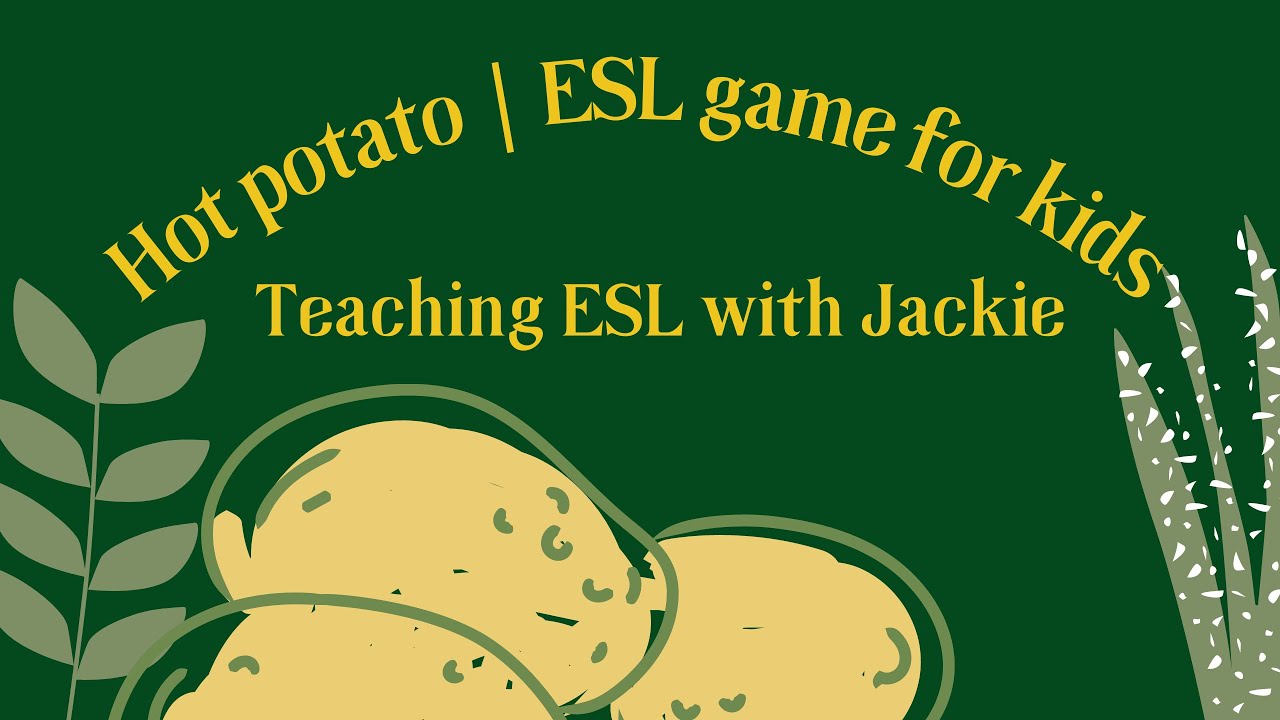
Fun ESL Speaking Activity for Kids: Hot Potato Game | Teach ...
59K views · Nov 23, 2022 eslactivity.org
The Hot Potato Game is a great way to get your ESL students to speak. This ESL activity is a fun way to get your students talking. Keep on reading for all the details about Hot Potato, traditionally a great party game that can also be used for a quick ESL speaking activity for a great warm-up or filler activity. Try out this hot potato game with your English learners today. They'll have a fun time reviewing key vocabulary words or practicing English grammar. Hot Potato is ideal for young learners but can also be used with all ages. ------------------- • An English Speaking activity for teens "Pictionary": : https://youtu.be/sbD2b2-lHxo • "The disappearing conversations" An Easy Activity to Improve ESL Speaking Skills ESL by: @Twinkl ESL: Resources for English Teachers https://youtu.be/VWFYC3ZquiU ------------------- More details about the hot potato game: Full blog post: https://eslspeaking.org/hot-potato-esl-speaking-game-for-kids/ Want to find more low or No Prep ESL activities, including Hot Potato? Check out: https://amzn.to/3KbTtgU -------------------- Check out another ESL speaking activity: https://www.youtube.com/watch?v=8MMCLcm58-A --------------------- https://www.facebook.com/eslspeaking https://www.pinterest.ca/eslspeaking/ https://www.instagram.com/jackie.bolen/ https://www.tiktok.com/@englishwithjackie?lang=en #teachingenglishwithjackie #hotpotato #eslgames Timestamp 0:00 Intro 0:12 What is hot potato? 0:27 The actual hot potato? 0:33 What about music? 0:47 How to prevent injuries 1:10 How to play hot potato 1:40 Variation for advanced students 2:18 Conclusion Transcript for the hot potato game for ESL: Hey everybody, this is Jackie from eslspeaking.org. Today I'm going to talk about one of my favourite ESL activities for kids. It's called hot potato and maybe you've played the game or seen the game before. It's where you pass around this like potato thing, there's a timer that goes off on it and then whoever is holding the potato is the loser. I kind of do a variation of it for my ESL classes. You can use the actual potato thing that you can find on Amazon or you can put some music on like on a youtube video or an mp3 file or whatever and then you can just control it yourself. You can even look on youtube like a hot potato song and then it'll even do it for you so it's quite simple to do. It's more random that way so you can pass around the potato or you can just get like any classroom object like a board marker, stuffed animal, anything like that. I prefer something kind of soft to avoid injury because you know students will be passing it quickly and sometimes they'll throw it so you know. I'm sure you can find something. So students pass it around and then whoever is holding the ball when the music stops, they have to do something. So this really depends on the age and level of students. If it's total beginners I would just have a stack of flashcards and I would just hold up the flashcard to them. whoever is holding the potato and I'd say, what is it and then they could say it's a dog. Or, I would ask a simple question so I'd show them a flashcard and I'd say what colour is the t-shirt? It's green, something like that. More advanced students, for example, if you're doing comparatives, you could show them two objects and then they could say, the cat is bigger than the dog, something like that. Or, the boy is shorter than the girl. I don't know something. So it can really be based on anything you want or if you're teaching maybe like about the simple past you could ask them questions like, what did you do last night? And then students could say I watched tv last night. Or, what did you do last summer? Well, last summer I went to an English camp, something like that. So get creative. There are a million different things you can do here. Tags: hot potato ESL, hot potato game, hot potato games, ESL hot potato, English grammar, speaking game, speaking activity, teachers, teaching activities, fun activities, games, english, learning english, esl games, english teacher, english, learning language, Classroom games, ESL kids, TEFL, TEFL activities, TEFL classroom, No prep games, Low prep game, Low prep activity, classroom activities, classroom tips, hot potato,
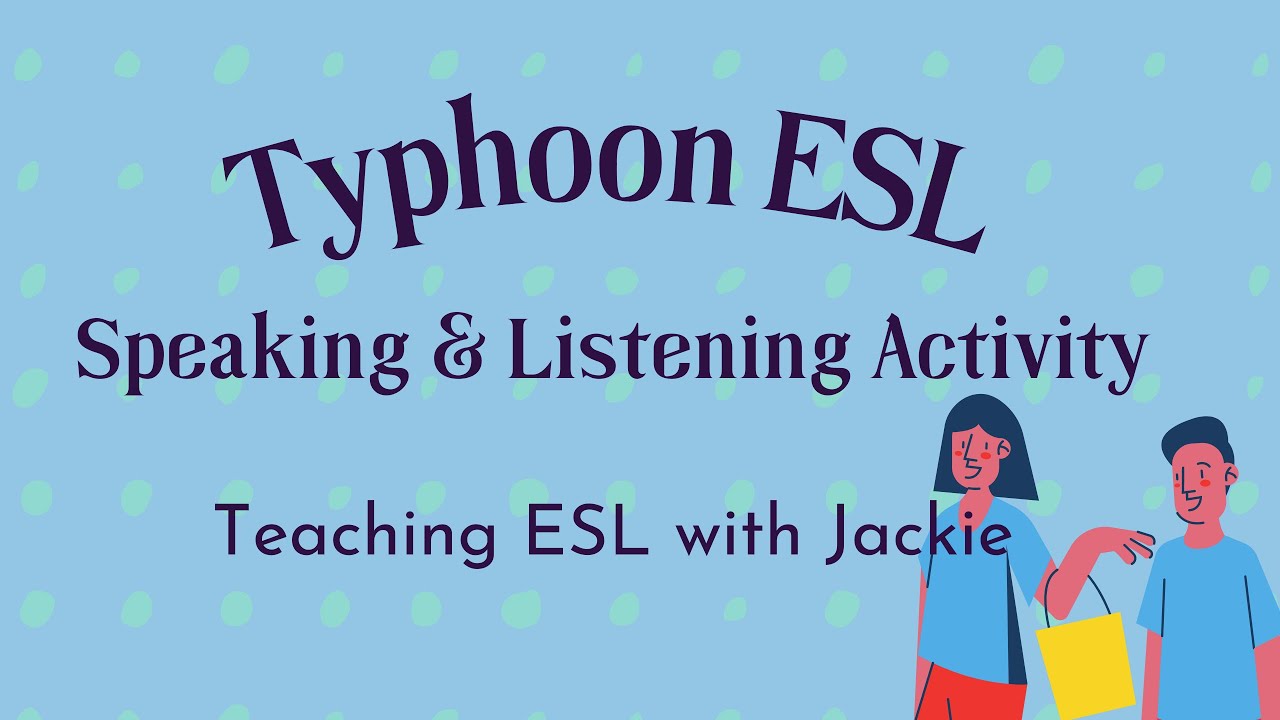
ESL Speaking and Listening Activity: Typhoon | A fun ESL rev...
67K views · Nov 23, 2022 eslactivity.org
If you’re looking for a fun review game for children, teenagers, university students, or adults, then consider using Typhoon! It’s heavy on the listening and speaking skills and it’s the game I usually play at least once a semester in the review class before a midterm or final exam. It’s so fun that students keep asking to play it again! ------------------- • Just a Minute ESL Speaking Activity: : https://youtu.be/wnJOTGxaN9w • A No Prep, No Resources Speaking Game for Intermediate ESL by: @Twinkl ESL: Resources for English Teachers https://youtu.be/F4EFt1_iQVU ------------------- Learn more about this typhoon ESL game: https://eslspeaking.org/typhoon-esl-game/ Want to find 100+ ESL activities? Check out my book: https://amzn.to/3dYOAJX -------------------- https://www.facebook.com/eslspeaking https://www.pinterest.ca/eslspeaking/ https://www.instagram.com/jackie.bolen/ https://www.tiktok.com/@englishwithjackie?lang=en #teachingenglishwithjackie #reviewgames #speakingenglish Transcript for Typhoon: Hi, this is Jackie from eslspeaking.org. Today I'm going to talk about typhoon. It's a fun ESL game that I use to review material before a midterm or final exam. I've used it with all ages from kindergarten students, to elementary school, high school, university students, and adults. They've all loved it equally. It's a very versatile game and it's slightly more interesting than kind of the standard Jeopardy. It's just something that students wouldn't have seen before. One of my friends at one of my universities in Korea came up with it and shared the idea with me. I think he actually came up with it by himself so it's kind of an original idea. Alright, so typhoon. I make up a grid usually like about five by five or six by six, and then I put letters a, b, c, d, e, and then across the top I put numbers one, two, three, four, five, six on the board. The students just have blank squares. They don't know what's in each square but I have a paper that lists questions for each square. There are also some special squares so if I have a board of 25 or 36, I would maybe have two typhoons. A typhoon is losing everything so all the points you have up to that point are gone if you choose that typhoon square. The next one is a hurricane. So hurricane is you lose minus five points so of course play it up. You could say something like...oh bad weather is coming and then I always write in the square the letter. So t for the typhoon, h for a hurricane, there's also easy medium and difficult questions, so e and t and h. All start the same one line down. So I write the one line and then students, is it easy ,is it difficult, is it typhoon, is it a hurricane, I like to drag it out very slowly and they get very excited about it. So that's hurricane and then the next one is vacation. So vacation is you just get five free points without having to do a question. Then the other squares are all filled with questions. Easy is one point. Medium questions are three points and then difficult questions are five points. So all of these questions are midterm or final exam review questions. So just whatever material you've been teaching in class you can do on your typhoon game. I put students into usually groups of like four or five people on a team and maybe four or five teams to play this game. Of course, adjust it depending on the class size and my rule is that students usually have to appoint a captain and if they get a question I'll say the question to them and give them a short amount of time, say like 20 seconds to discuss their answer with their team. And then the captain will say the answer for their team. If correct, they get the points. If incorrect, I sometimes will subtract the points for higher level classes which is kind of mean or for lower level classes just nothing happens. They just don't get the points. Timestamp: 0:00 Intro 0:30 Where I found typhooon 0:40 How to set it up 1:00 How to play 2:06 Question squares 2:25 Group size & rules 3:08 Summary Tags: Speaking and Listening Activity, ESL review game,typhoon games,typhoon game,typhoon games for free,review game,typhoon esl,typhoon esl game, typhoon esl games, typhoon esl activity, english speaking game, english listening game, english speaking activity, english listening activity,
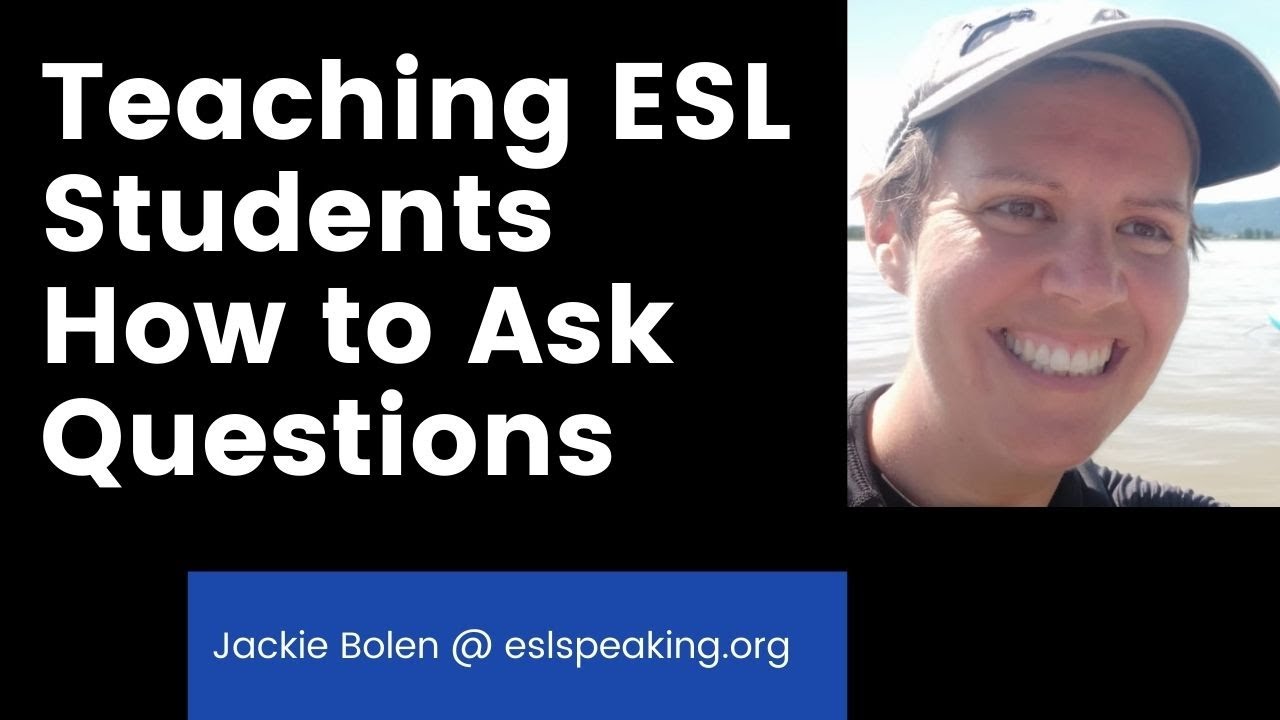
Teach Students How to Ask Questions in ESL/EFL/TEFL Classes:...
28K views · Nov 23, 2022 eslactivity.org
It's often the case in ESL/EFL classes that the teacher asks the questions and the students answer them. However, it's vital that students learn how to ask questions as well! Find out how to get ESL students asking good follow-up questions in English class today. Check out these tips and tricks for getting English learners to practice asking questions, including some advice about games and activities. Follow-up questions are key to conversation so give students a chance to practice them in class. Find out how to do it here! Stay tuned for everything teaching English students how to ask better questions. Want to know more? Check out: https://www.eslactivity.org/wh-questions-activities/ 101 ESL Activities for Adults: https://amzn.to/3ulTAhG Even more Ideas for the TEFL Classroom: https://eslspeaking.org/ https://www.facebook.com/eslspeaking https://www.pinterest.ca/eslspeaking/ Tags: esl, esl speaking, esl speaking game, esl speaking activity, esl speaking adults, esl speaking teenagers, tefl, esl abroad, teach english, english conversation, english speaking, speaking english, teaching esl, teaching english abroad, teaching esl speaking, teaching english speaking, how to teach speaking, how to teach english, education, elt, esol, wh questions, wh question, yes no questions, yes or no question, teaching esl adults, teaching esl kids, Teaching ESL Speaking
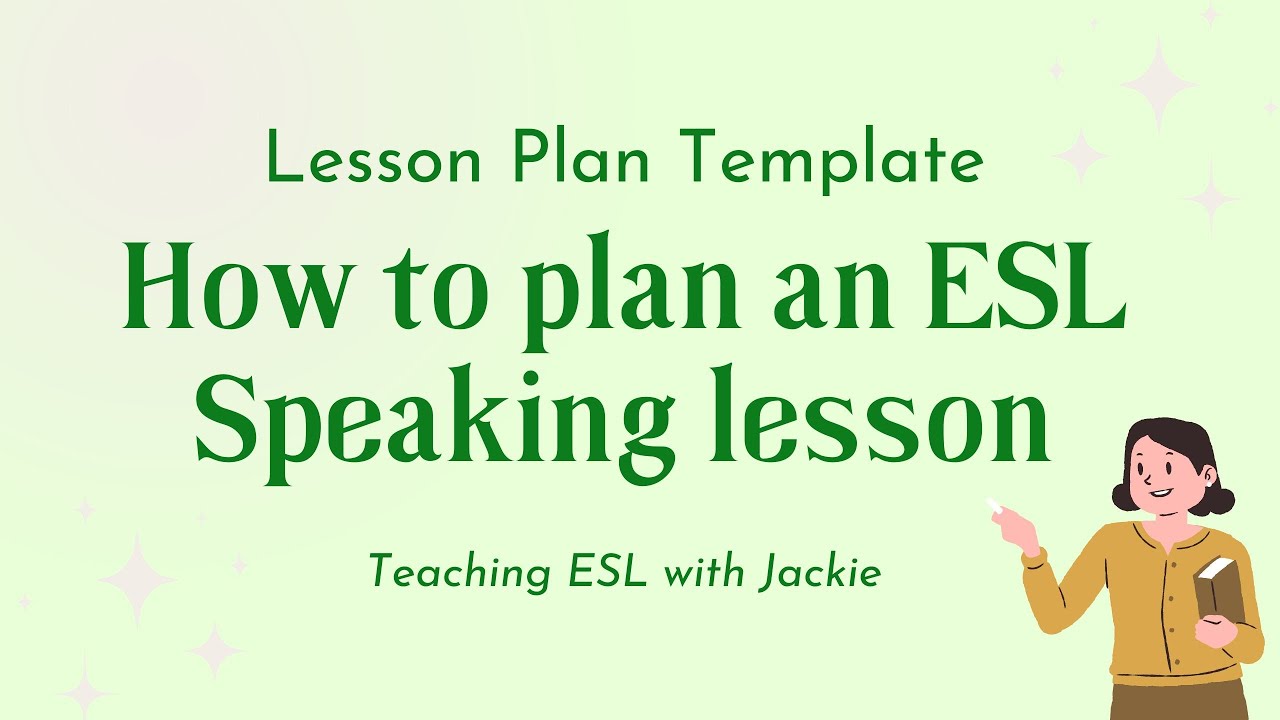
How to Plan an ESL Speaking Lesson in less than 10 steps | L...
43K views · Nov 22, 2022 eslspeaking.org
Are you an ESL teacher and need help planning an ESL Speaking lesson? Well, you’ve certainly come to the right place! Keep watching for all the details, including precise steps on how to teach a speaking lesson. We’ll give you the information you need to get started with ESL speaking lesson plans. ------- • Check out this ESL speaking lesson planning template: https://eslspeaking.org/esl-speaking-lesson-plan-template/ • If you liked this video and want more lesson planning videos, watch this listening one here: https://youtu.be/mcTLTCjtRJo • Want some resources to find more lesson plans? Watch this video from @Enjoy English With Mrs. A : https://youtu.be/3dG83cCA7L8 ------ More ideas for teaching ESL speaking: Check out 101 ESL Activities for Teenagers and Adults: https://amzn.to/3wGgUsX https://www.facebook.com/eslspeaking https://www.pinterest.ca/eslspeaking/ https://www.instagram.com/jackie.bolen/ https://www.tiktok.com/@englishwithjackie?lang=en #esl #teachingenglishwithjackie #lessonplan ------------------------------------------------------- Even more Ideas for the TEFL Classroom: https://eslspeaking.org/ -------------------------------------------------------- Timestamp for how to plan an ESL speaking lesson: 0:00 Intro 0:13 What is a good lesson focus? 0:35 Step 1: Set the context 1:04 Step 2: Focus on meaning 1:40 Step 3: Focus on forms 1:56 Step 4: Pronunciation 2:11 Step 5: Controlled practice 2:33 Step 6: Freer practice 2:57 Step 7 (Optional): Homework or review Transcript for this ESL speaking lesson plan template: Today I'm going to talk about how to plan an esl speaking lesson. So first of all, getting students to just speak isn't really a good focus of the lesson. It's better to choose a more specific grammar or vocabulary point and then students can practice that through speaking. The example I'll choose is irregular past tense verbs and then the theme of the lesson might be past vacations of some kind. The first step in planning an ESL speaking lesson is to set the context. It could be very simple. You could just get students to maybe just shout out the last place they went on vacation. Or, it could be thinking about some maybe like travel disasters that could happen like you lost your passport, you lost your wallet, something like that. You could do it together as a class or you could just get students to talk with a partner just for a minute or two. The next thing is to focus on meaning. If you teach language, it's a little bit useless if you teach language removed from situations in which students can use it. So if I'm teaching irregular past tense verbs, then I want students just to automatically think in their heads, oh I can use this to talk about past vacations or something that happens in the past. That's why it's important to set the context and then also to spend some time focusing on meaning. By that, I mean a focus of the lesson. For example, past travel stories. Then focus on forms. For this example that I chose, point out the most common irregular past tense verbs such as ate and went and don't forget the negative forms as well as question forms. Then I focus on pronunciation. It's not super helpful to teach language to students if they can't really say it and I know I feel a bit shy about teaching pronunciation but it actually is quite valuable and it just takes a minute or two to do it. Do some kind of repeat after me things. Next is controlled practice. There are a million worksheets on the internet. I sometimes make my own worksheets. You can often find little exercises in the textbook as well so just have a look and you should be able to find something quite easily. I get students to work on it by themselves and then I have them very quickly compare together with a partner and then we quickly discuss answers as a class. After that is some freer practice. So there's a whole range of related games and activities you could do to talk about holidays or vacations using irregular past tense verbs. If you need some ideas for that, be sure to check out my book 101 ESL Activities for Teenagers and Adults. I'll put the link right up there for you. An optional thing to do is to give some homework or to do some review in the next class. I love to review things because if you just tell students the first time, they're not going to pick up on it. When you're learning a language, you have to see things multiple times over and over and over again to really get it. So that's all for me. Those are the steps to plan an esl speaking lesson. Tags: How to plan a lesson, ESL speaking, esl speaking lesson, lesson planning for english, english lesson plan, how to teach esl speaking, how to teach english speaking, english speaking teacher, teacher tips, teaching tips, how to teach, how to teach speaking, classroom planning, english speaking lesson, english speaking ideas, english teaching ideas, How to plan an esl speaking lesson, step by step, esl,

The Talking Bag activity: An ESL Speaking Game | Teaching ES...
144 views · Nov 22, 2022 eslspeaking.org
Talking Bag is an ESL speaking game that you should try in your class for September! All you need is a bag or box, some paper and students willing to learn this fun speaking activity. This is "Talking Bag", a speaking activity for all ESL students. For the full video with more details on how to play the Talking Bag, plus lesson plans, tips & tricks on how to teach ESL speaking, watch here: https://youtu.be/mj0oeSRfKt8 ------- • Want to find 39 Low-Prep/ No Prep ESL activities? Check out my book: https://amzn.to/3eHqWRo ------ https://www.facebook.com/eslspeaking https://www.pinterest.ca/eslspeaking/ https://www.instagram.com/jackie.bolen/ https://www.tiktok.com/@englishwithjackie?lang=en #esl #teachingenglishwithjackie #shorts ------------------------------------------------------- Even more Ideas for the TEFL Classroom: https://eslspeaking.org/ -------------------------------------------------------- Transcript for Talking Bag: The talking bag. So if your favourite thing is surveys, mine is the talking bag. And it can be a talking box or a talking jar or whatever. All it is is a collection of question cards that I make myself. You know and but I'm sure you can find free ones online, you can buy them online whatever, but it's just a bunch of questions. And you can make them, you know easier questions for more beginner students or more difficult questions or you know thematically related to your lesson, whatever. But you just put them all, I carried mine in a bag. So I would just have a bunch of them in there and the students would stick their hand in draw out a card and ask a question to another student who has to answer it. Tags: ESL speaking game, ESL speaking activity, teaching ESL speaking, teaching English speaking, English speaking games, talking bag, talking bag game, speaking game, speaking activity, teaching college English, teaching highschool English, teaching English to kids, teaching English to teens, teaching English to adults, teaching English to teenagers,
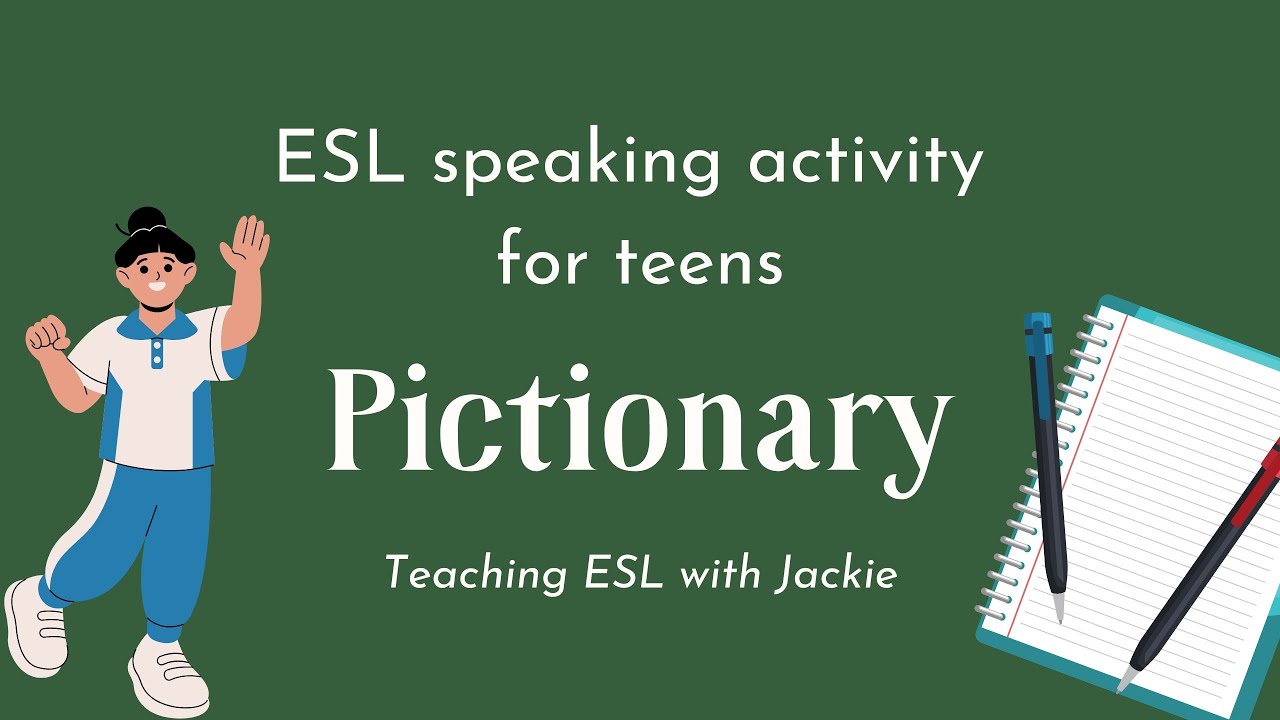
An English Speaking activity for teens: Pictionary | A fun E...
15K views · Nov 22, 2022 eslspeaking.org
A fun English-speaking activity that's perfect for teens: Pictionary. I’m sure you’ve played this fun game yourself before. You have to draw words or phrases and then your teammates guess what it is. It’s a nice classroom game to review new vocabulary so be sure to give it a try with your students. ------- • Check out this blog post for more ESL/EFL games to play in class https://eslspeaking.org/games-to-play-in-class/ • If you liked this video, find my teaching playlist here: https://youtube.com/playlist?list=PLL0Q8kr18oQKFDBcKGvNh_av3em-Byajj ------ 39 ESL Review Activities: https://amzn.to/3pgMPwU https://www.facebook.com/eslspeaking https://www.pinterest.ca/eslspeaking/ https://www.instagram.com/jackie.bolen/ https://www.tiktok.com/@englishwithjackie?lang=en #esl #teachingenglishwithjackie #eslactivities ------------------------------------------------------- Even more Ideas for the TEFL Classroom: https://eslspeaking.org/ -------------------------------------------------------- Timestamp for this Pictionary review activity: 0:00 Intro 0:10 What is Pictionary? 0:21 How to play Pictionary 0:58 Conclusion Transcript for ESL Pictionary: Pictionary is one of my favourite ESL or EFL review activities. I'm sure you've played the game before. It's when you pick a sentence or a phrase and then you have to draw it on a board and then your teammates have to guess what it is. It also makes a great ESL review activity. So I put in a little bag or a box, all the words or phrases that I want to review in my class. And then I put students into two teams. Someone from that first team comes up, picks a word out of the box and then draws it on the board and their team has to guess what it is in English, of course. I don't allow them to use their first language if they have a common first language. And then I usually will give them a time limit. So I'll say like a minute for each round. Once they get that first word, they can draw another word out of the box and try to get as many points as possible in that first round or that one minute. Then the other team goes for one minute and then you can play as many rounds as you wish. Okay, so that's about it for this activity. If you want some more ideas, please be sure to check out 39 ESL Review Activities. I'll put the link right up there and please hit like, subscribe and leave a comment telling me what is your favorite vocabulary review activity. Tags: English speaking activity, English speaking activity for teens, English speaking activity for teenagers, games to play while in class, best games to play during class, English review games, reviewing english, english review activity, how to teach English, EFL, ESL, classroom review games, classroom play, Pictionary, Pictionary game, Pictionary for class, how to teach English, teaching English to teenagers, Reviewing English,

Top 5 Tips for Teaching Conversational English | How to Teac...
89K views · Nov 22, 2022 eslspeaking.org
Many foreign ESL teachers abroad, especially in places like South Korea, teach predominantly English conversation classes. Some teachers (and students too!) have the perception that teaching English conversation involves just “talking” to the students. However, there's a lot more to teaching conversational English than just free-talking. Check out some of the best tips for teaching TEFL conversation and speaking. In my years of teaching, back-and-forth conversation has been a great way to teach and learn. Watch this video to find out how to teach conversational English and have an awesome English conversation class! Want to find out more? Check out: https://eslspeaking.org/english-conversation-class/ 101 ESL Activities for Adults: https://amzn.to/2QEqH1B Even more Ideas for the TEFL Classroom: https://eslspeaking.org/ https://www.facebook.com/eslspeaking https://www.pinterest.ca/eslspeaking/ https://www.instagram.com/jackie.bolen/ https://www.tiktok.com/@englishwithjackie #teachingenglishwithjackie #englishconversation #teachingenglish #esl Tags: teaching conversational english, teaching english conversation, teaching conversation english, teaching esl conversation, esl conversation, english conversation, conversational english class, conversation english classes, how to teach english conversation, how to teach esl conversation, conversation english class, english class, english lesson, esl, efl, tefl conversation class, tefl conversational english class, tefl conversation, conversation english lesson, conversation Transcript: Hi everybody, this is Jackie from eslspeaking.org. So today I have my top five tips for teaching conversational English classes or ESL/EFL/TEFL classes, etc. My first tip is to make it as student-centred as possible. This is something that I always thought, that my classes were student-centred but I took the CELTA course and my tutor actually challenged me. He just said you know what, it is student-centred but you could make it a lot more of that. The way I think about it is that I try to get my students talking and participating, writing, reading, listening, and doing things as much as possible. They need more practice with English, not me. So any time I'm at the front of the class talking, I think, can I minimize this? Can I get my students doing the hard work and not me? Just keep that in the back of your mind. The next one for conversational English is to teach students to ask follow-up questions. It's kind of a weakness of many students. It's easy to get in the habit of the teacher asking a question, how are you? I'm good. How's the weather? It's sunny. What are you doing this weekend? Oh, I'm playing soccer. And students never really ask questions back and they also aren't great at asking follow-up questions. Who do you play soccer with? Or, if the answer is, I'm gonna catch a movie, then, what movie are you watching? Just simple things like that. The next one is error correction. So error correction is a little bit tricky in a conversational English class. It's a bit demoralizing, especially for beginners if you correct every single error that students make. And I mean, I get it. I've been there in my language studies. Just a general kind of rule that I have. I actually have two general rules. The first one is that I correct all errors related to the target language. Wo if we're studying or I'm teaching about the simple past, I'll correct all errors related to the simple past. Another rule that I have is that I'll correct errors related to something we've already just covered in that class, say in the past week or two. If I'm teaching about maybe the future tense, but the previous week we'd covered the simple past and a student made a simple past error, I'd probably just quickly remind them about that. So the next tip for teaching conversational English is to set the context. By setting the context I mean you can teach the simple past, the present continuous, whatever you're teaching but students need a reason to use that language or a situation in which they can use the language by setting the context. There are various ways to do it. You can tell a story, get students to talk about a little topic related to what you're teaching, do a little warm-up game or activity, make a prediction about maybe like a headline they see in the text, they can watch a little bit of a video and then you stop the video and students can predict what's going to happen. The final tip that I have is to review. Repetition is key. I'm not sure of the exact number, but studies have shown that when you learn a language, things don't really stick until you see them a certain number of times. This is true for vocabulary, grammar, whatever it is. I always do my best to help students with this process. Timestamp 0:00 Intro 0:12 Make it student-centred 1:03 Follow-up questions 2:06 Error correction 3:27 Set the context 4:27 Review lots 5:35 Conclusion
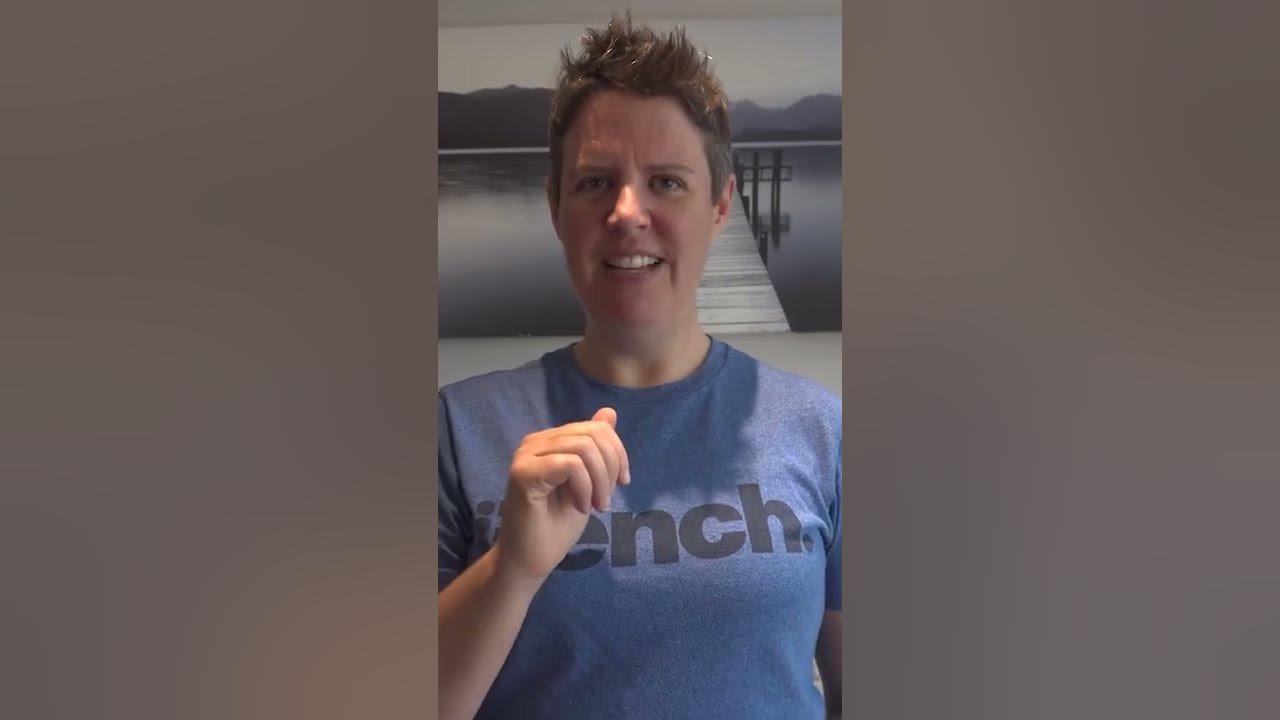
Dialogue substitution, a Quick ESL reading and speaking acti...
5K views · Nov 22, 2022 eslspeaking.org
If you want to help your students out with remembering new vocabulary words, then check out this ESL dialogue activity. Instead of just reading an ESL dialogue mindlessly, students have to fill in the blanks with keywords that you’ve given them. Teaching English with dialogues is one of my favourite ways for students to see new words or grammar points in context. This TEFL activity is a nice way to increase the difficulty of a simple ESL conversation dialogue that you can often find in textbooks. Try this out for dialogues for ESL students and you'll notice a difference in how engaged students are when reading it. This is the basic instructions for the Dialogue substitution activity, for the full video watch here: https://youtu.be/NB_NXSR4_4g ------- • Full blog post with worksheets and more: https://amzn.to/3dYOAJX • Don't forget to check out @JustTeach(byLittleMary) video about more speaking activities: https://youtu.be/z1MWlSmQb7E ------ Want to find more activities for teaching ESL, including dialogue substitution? Check out: https://amzn.to/3dYOAJX https://www.facebook.com/eslspeaking https://www.pinterest.ca/eslspeaking/ https://www.instagram.com/jackie.bolen/ https://www.tiktok.com/@englishwithjackie?lang=en #esl #teachingenglishwithjackie #shorts ------------------------------------------------------- Even more Ideas for the TEFL Classroom: https://eslspeaking.org/ -------------------------------------------------------- Transcript for Dialogue Substitution: Today I'm going to talk about dialogue substitution. It's one of my favourite ESL reading and speaking activities. Have you ever experienced this in your class? It happens to me all the time/ You know, there are those little dialogues in the textbooks that are often kind of like the lead-in to the rest of the unit. I put students into pairs and I tell them, okay read the dialogue with your partner. And just blah blah blah blah blah blah blah blah and they're finished. And then I say, okay so that guy Bob and I asked a question about Bob from the dialogue and everyone's like what? Who's Bob? And they actually, legitimately have no idea who Bob is. What Bob did. What Bob said. Even though they had just finished reading it with their partner. Do you know what the problem is? It's not with my students, it's with me because I didn't give them a reason to actually read carefully. Instead, remove some of the key words! Tags: esl,esl activities,learning games,teaching esl,teachers,teaching activities,teaching prompts,fun activities,games,english,English for beginners,learning english,esl games,english teacher, esl activities for adults, esl activities for teens, shorts, short, youtube shorts, shorts for teachers, dialogue substitution, quick esl, quick esl reading, quick esl speaking, esl speaking, esl reading,
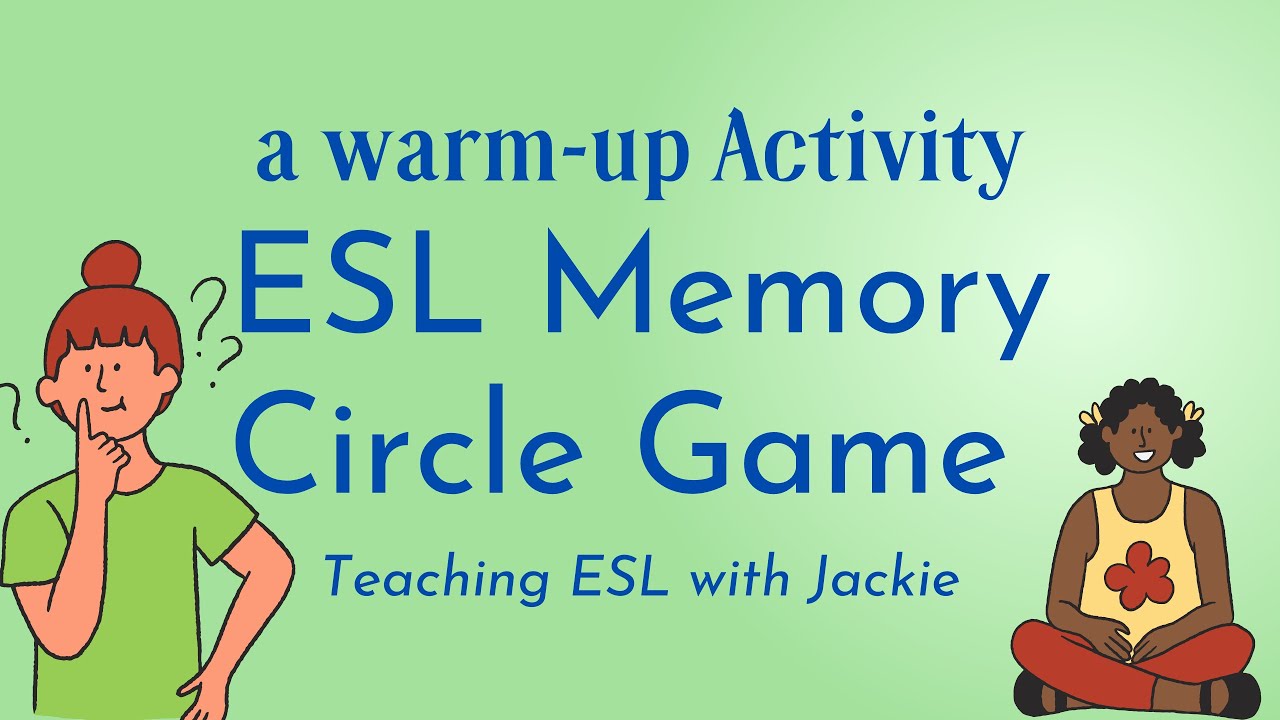
Memory Circle (ESL Grammar Game for Kids) | ESL Speaking for...
19K views · Nov 22, 2022 eslspeaking.org
Check out memory circle, a fun ESL game to help students remember names, new grammar or vocabulary. Try out the Memory Circle game today. This exciting speaking game is the perfect game for young learners. Keep on watching for more details about memory circle, an ESL activity that kids love, but you can also use it with teens or adults. ------- • Full blog with worksheets and more: https://eslspeaking.org/the-memory-circle-game-esl-speaking-for-kids/ • If you liked this video, find 10 speaking activities to teach to all learners here : https://youtu.be/9BPf8gIx07M • Want another grammar activity you can teach to kids? Teaching ESL Grammar Games for Ells by @The Language Lady : https://youtu.be/Mp2O2NtS53I ------ Want 101 ESL Activities for Kids? Check out my book: https://amzn.to/3G28rEE https://www.facebook.com/eslspeaking https://www.pinterest.ca/eslspeaking/ https://www.instagram.com/jackie.bolen/ https://www.tiktok.com/@englishwithjackie?lang=en #esl #teachingenglishwithjackie #eslspeaking ------------------------------------------------------- Even more Ideas for the TEFL Classroom: https://eslspeaking.org/ -------------------------------------------------------- Timestamp for Memory Circle: 0:00 Intro 0:20 How to play Memory Circle 1:05 Another way to utilize Memory Circle 1:38 If you want more activities for kids, check out my book 101 ESL Activities for kids Transcript for Memory Circle Game: Today I'm going to talk about just a very simple warm-up or review activity that you could use in your ESL classes. It's called memory circle. So if you want to use memory circle as kind of a name game, ice breaker warm-up kind of thing, you could get students to say a true statement about themselves. My name is jackie and I like cats. Then the next person in the circle could go and repeat what they've already heard. Her name is Jackie and she likes cats. My name is Bob and I like ice cream. The third person goes. Her name is Jackie and she likes cats. His name is Bob and he likes ice cream and my name is Katie and I love shoes. Whatever it is and you just go around in the circle. It's a really nice way for students to learn each other's names and you can change what students have to say to basically anything. Like what kind of food people like, what kind of hobbies, etc. The other way to use this activity is as a review activity. So for example, if you're talking about the simple past you could get students to say what they did last night. My name is jackie and I went paddle boarding and then the next person: Her name is Jackie and she went paddle boarding. My name is Tom and I made pizza. And you just continue on that way and the one rule I would make is the students have to use a different past tense verb for their own statement. Okay, so that's about it. That is my very simple memory circle ESL activity. If you want some more activities, be sure to check out my book 101 ESL Activities for Kids. I'll put the link right up there for you and also be sure to hit like, subscribe, and leave a comment below and say hi. Tags: Memory game, Memory Circle, teaching kids English, teaching young learners, young learner, games for kids, teaching speaking English, learning English, How to speak English, How to speak English easy, Learning English easy, ESL speaking, English speaking success, esl memory circle game, memory circle esl game, memory circle game for kids, memory circle game adults
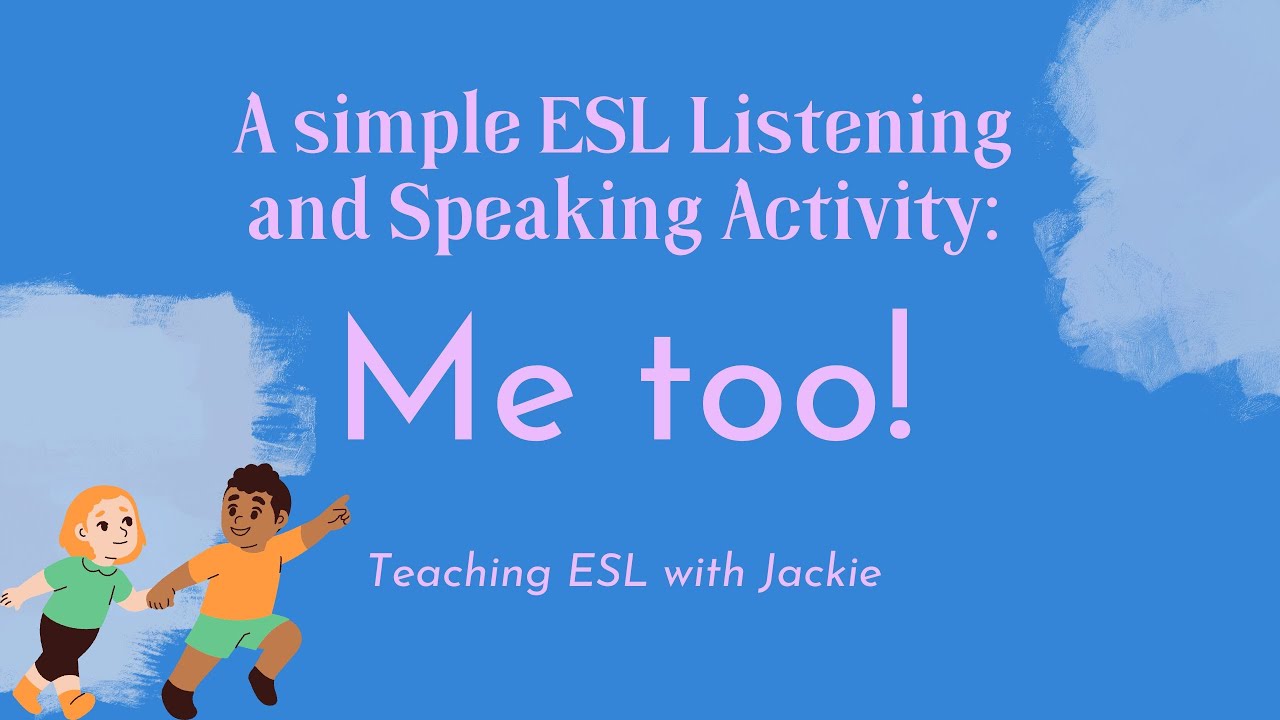
A Simple ESL Listening and Speaking Activity: Me Too | Teach...
12K views · Nov 22, 2022 eslspeaking.org
I’m all about simple activities that require nothing in the way of preparation or materials and can fill a few minutes at the end of class. The best ones are often fun ESL listening and speaking activities. Me Too! is one of those activities but it’s not just a time-filler—it can be used to review key grammar and vocabulary and it also focuses on listening and speaking skills. Keep watching for an amazing game to play with young learners. ------- • Check out this blog post for more details about this listening and speaking activity for ESL: https://www.eslactivity.org/me-too-esl-speaking-listening-activity/ • If you liked this video, find my teaching playlist here: https://youtube.com/playlist?list=PLL0Q8kr18oQKFDBcKGvNh_av3em-Byajj • Want 3 more amazing ESL listening activity? Check this video by @Just Teach (by Little Mary) : https://youtu.be/zkvwTsY1oXk ------ More No-Prep, low prep activities for kids: https://amzn.to/3uE9TJ8 https://www.facebook.com/eslspeaking https://www.pinterest.ca/eslspeaking/ https://www.instagram.com/jackie.bolen/ https://www.tiktok.com/@englishwithjackie?lang=en #esl #teachingenglishwithjackie #eslactivities ------------------------------------------------------- Even more Ideas for the TEFL Classroom: https://eslspeaking.org/ -------------------------------------------------------- Timestamp for this listening and speaking activity: 0:00 Intro 0:11 Ideal for beginners 0:22: What is Me Too? 1:00 Try out this speaking and listening activity 1:11 Conclusion Transcript for Me Too: Hi, this is jackie from eslspeaking.org. Today I'm going to talk about a simple listening activity that's great for beginners. it's called me too. So this activity works best if students can sit in a circle or kind of just in a location where they can kind of all see each other quite easily. Students have to think of a true statement about themselves. For example: - I have a cat. - I like pizza. - I don't like playing sports. Whatever it is. The student says I have a cat and then if other students in the class could also say that's true for themselves, they stand up and then they say me too. And then everyone can kind of look around and they could say, you have a cat too? Or, you play soccer as well? or just whatever the statement was. Everyone sits down and then the next person in the circle says their true statement about themselves and then whoever it's also true for, everyone stands up and says me too. Super simple! It's great for kids and yeah it's ideal for beginners. It's kind of a simple, very, very simple listening activity and also a bit of a speaking activity as well. Alright, if you like this activity please be sure to check out my book 39 No-Prep, Low-Prep ESL Speaking Activities for Kids. Tags: Me Too game, Me Too Activity, Teaching children, Listening and Speaking Activity, Speaking activity, Listening activity, English Listening Activity, English Speaking activity, ESL Listening, ESL Speaking, teaching, teaching English, teaching ESL, ESL teacher, easy lesson plan, teaching young learners, young learner, games for kids, teaching speaking English, TEFL listening and speaking activity
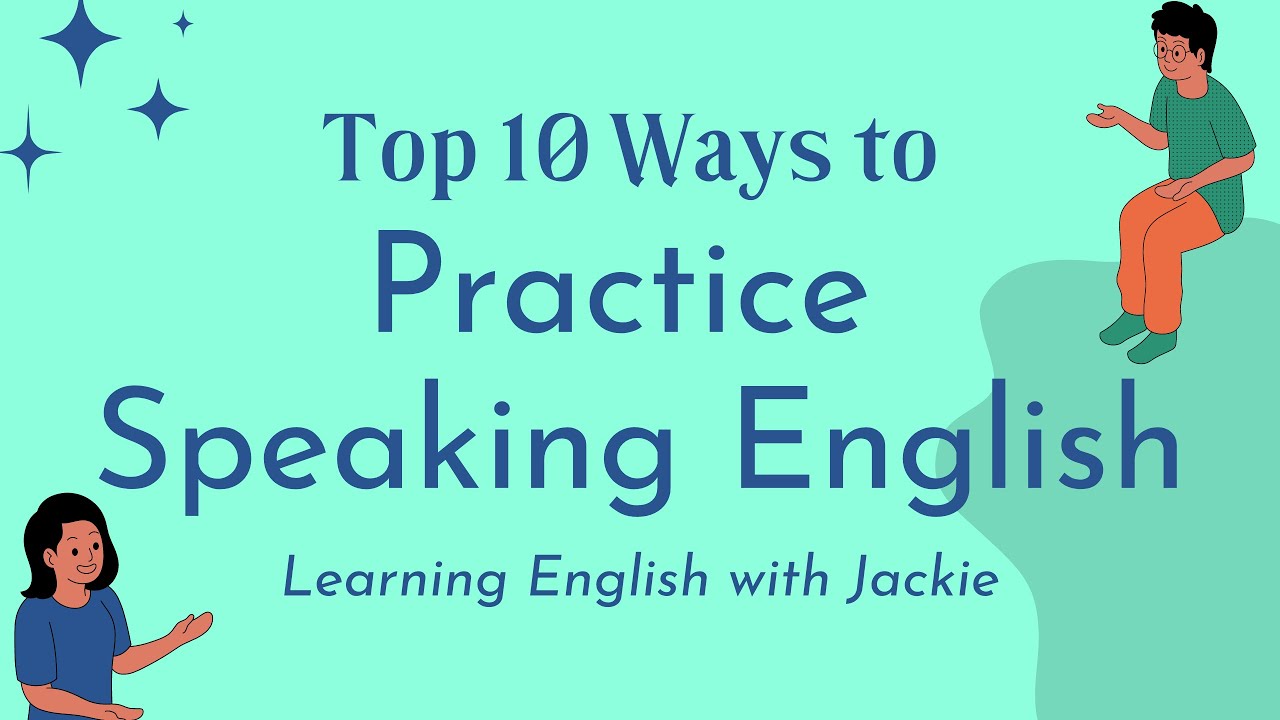
Practice Speaking English in 10 easy steps | Learning Englis...
10K views · Nov 22, 2022 eslactivity.org
Learn how to practice speaking English in 10 easy steps by watching this video. We’re going to give you the rundown on everything you need to know to practice getting your English skills up, even if you don’t speak English as your first language. So keep watching for all the information about learning to speak English well! ------- • Full blog with worksheets and more: https://eslspeaking.org/category/learn-english/ • If you liked this video, learn how to do a self-introduction here: https://youtu.be/MkPugKMgu2M • Watch how to practice speaking English alone with @English Speaking Success : https://youtu.be/9gpmxN5SlNM ------ Want 1001 English Expressions and Phrases? Check out my book: https://amzn.to/3LwjBCw https://www.facebook.com/eslspeaking https://www.pinterest.ca/eslspeaking/ https://www.instagram.com/jackie.bolen/ https://www.tiktok.com/@englishwithjackie?lang=en #esl #speakingnglishwithjackie speakingenglishwithjackie #eslwarmup ------------------------------------------------------- Even more Ideas for the TEFL Classroom: https://eslspeaking.org/ -------------------------------------------------------- Timestamp 0:00 Intro 0:12 Tip #1: Join a meetup group 0:43 Tip #2: Get a language exchange partner 0:53 Tip #3: Pay a tutor 1:15 Tip #4: Sing in English 1:27 Tip #5: Think in English 2:03 Tip #6: Talk to yourself in English 2:22 Tip #7: Focus on fluency 2:32 Tip #8: Listen and repeat 2:50 Tip #9: Phrases and Collocations 3:28 Tip #10: Read in English 4:00 Outro Transcript for Practice Speaking English: Hi, this is jackie from esleaking.org. Today I'm going to talk about my top 10 tips to practise speaking English. Tip number one is to join a meetup group. If you live in a place like Canada or USA or England where people speak English as their first language, whatever your hobby is, just join that meetup group and go on a hike with people, go out to eat, whatever your hobby is and that you like doing. Just join in with some English speakers doing that as well. Get a language exchange partner. So if you speak Korean, find somebody who wants to speak Korean and you can learn from each other. The next one is you can pay a tutor. It's great just chatting with friends or going to a meetup group but if you want some serious English teaching and English conversation help with English speaking practice, paying someone might be the best way for you. You can find a person in the country where you're at or online. There are a million different options for that. The fourth thing you can do is sing in English. You can often find some popular songs with lyrics on YouTube. Play it loudly, sing along and learn the lyrics as well. The next one is to think in English. To the best English students, or the best students of any language actually think in that original language. They don't necessarily think in their first language and then translate. Try to get out of the habit. So just when you're out walking around the street or you're at home doing things you can just kind of talk to yourself a little bit. Just get in the habit of speaking and thinking in English. The next tip is quite related. It is talking to yourself and having a little chat with yourself all the time. Just think like, I'm making dinner now and then I'm gonna go see my friend Jenny and then when you're getting ready for bed just think, I'm gonna brush my teeth now and then I'm gonna go to bed. The next one is to focus on fluency. English students often get very worried about making mistakes. Don't worry too much about it. Worry more about getting your point across and then speaking quickly. Number eight: listen and repeat. If you have a favourite tv show or a podcast you can listen to a sentence or two, press pause and then repeat. This is a nice way to practice English if you're alone. Tip number nine is to learn phrases and collocations. If you learn each word individually, I mean you can learn well that way but the better way is to learn phrases. So for example something like, how are you. Tip number 10 is to read in English. I know this isn't related to speaking or doesn't seem like it's related to speaking but it actually is. The best english speakers read a lot and they listen to a lot as well. So find something that's interesting to you. It could be something online: a newspaper a magazine, maybe like a novel, maybe even a kid's book, something like that and then read regularly. So those are my ways to practice speaking English. Tags: speaking English, learning English, How to speak English, How to speak English easy, Reading in English, Learning English easy, ESL speaking, English speaking success, English phrases, English collocations, English fluency, Singing in English, ESL, Tutoring online, English tutor online, Reading an English book, Listening in English, Talking in English, English,
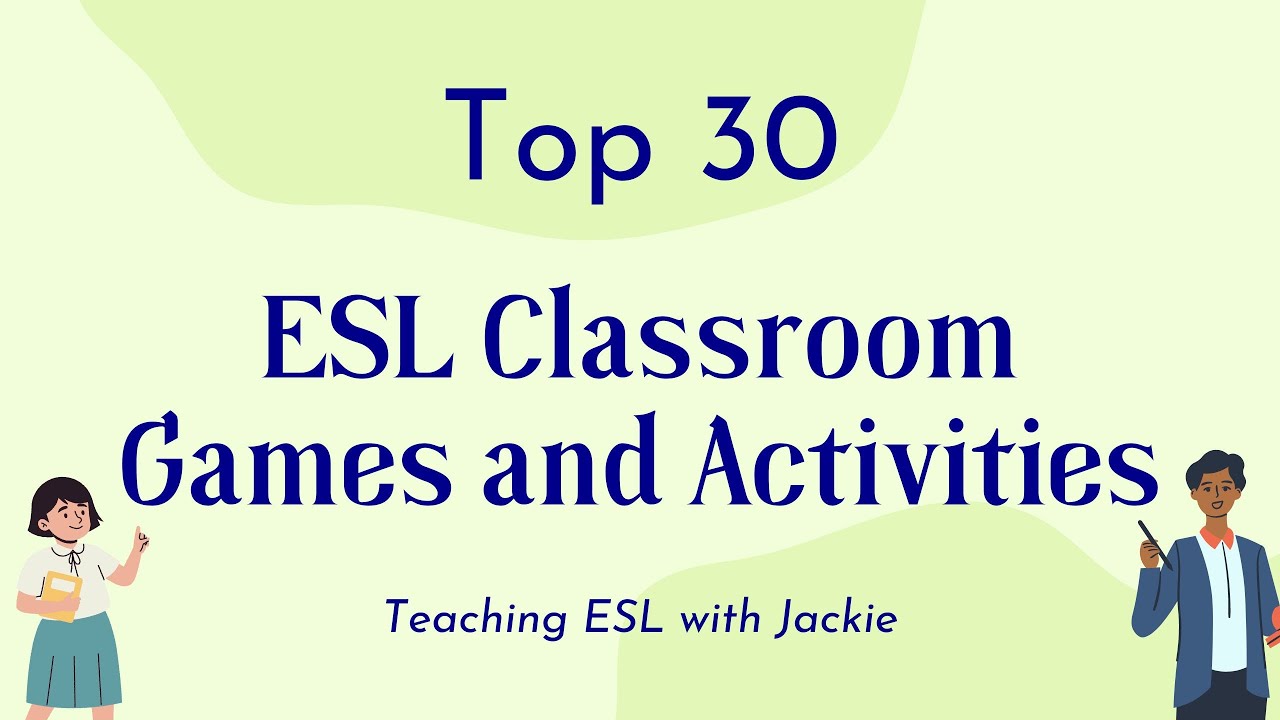
Top 30 ESL Classroom Games and Activities | Teaching ESL to...
427K views · May 2, 2023 eslspeaking.org
Here are my top 30 ESL Classroom Games and Activities for students of any age! This is a must-watch for ESL teachers. Keep on watching for 30 of the best ESL classroom games. ------- • Check out my blog for the ultimate resource on ESL games and activities: https://www.eslactivity.org/ • Watch my playlist here for more ideas on what to teach your classes! https://youtube.com/playlist?list=PLL0Q8kr18oQKbg2gr0CIt-ibFPl8f4oCL ------ Check out my book: 101 ESL Games for Kids https://amzn.to/3IlYxjV https://www.facebook.com/eslspeaking https://www.pinterest.ca/eslspeaking/ https://www.instagram.com/jackie.bolen/ https://www.tiktok.com/@englishwithjackie?lang=en #teachingenglishwithjackie #eslactivities #eslgames -------------------------------------------------------- Timestamp: 0:00 Intro 0:04 Line Up Activity 0:58 SOS Whiteboard Game 2:00 Apples to Apples ESL Vocabulary Game 3:05 Password ESL game for Teenagers 4:12 3 Things activity 5:36 Pictionary ESL game for Teenagers 6:30 Dialogue Substitution a speaking and reading activity 8:07 Dictation 9:55 Error Correction Relay Race 11:30 Menu's an Esl food activity for all ages 12:21 Ball Toss 13:04 Agony Aunt listening and reading activity 15:27 Flip Chart 16:21 Memory Circle 17:48 Five Senses 20:34 Fly Swatter 21:44 Idiom Activity 22:43 Surveys 23:29 Secret Job 24:33 Two Truths and a Lie 25:07 Postcards 26:34 Proofreading and Editing 28:00 Round Robin Story 29:19 Is That Sentence Correct 29:54 Show and Tell 31:05 Me Too! 32:08 I'm an Alien 32:59 Word Association 34:33 Word Challenge Whiteboard Race Tags: esl, esl games, english as a second language, ESL Classroom Games and Activities, esl games and activities, Teaching ESL to English Learners, fly swatter vocabulary game, apples to apples adults version, fun tutoring activities, fly swatter game, type of sentences games, types of sentences games, warm up worksheets, word association exercises, esl brains, ball tossing game, teens in classroom, esl review, teaching english to teens, teaching english to adults, teaching english to kids, esl idiom games, esl reading lesson plan,